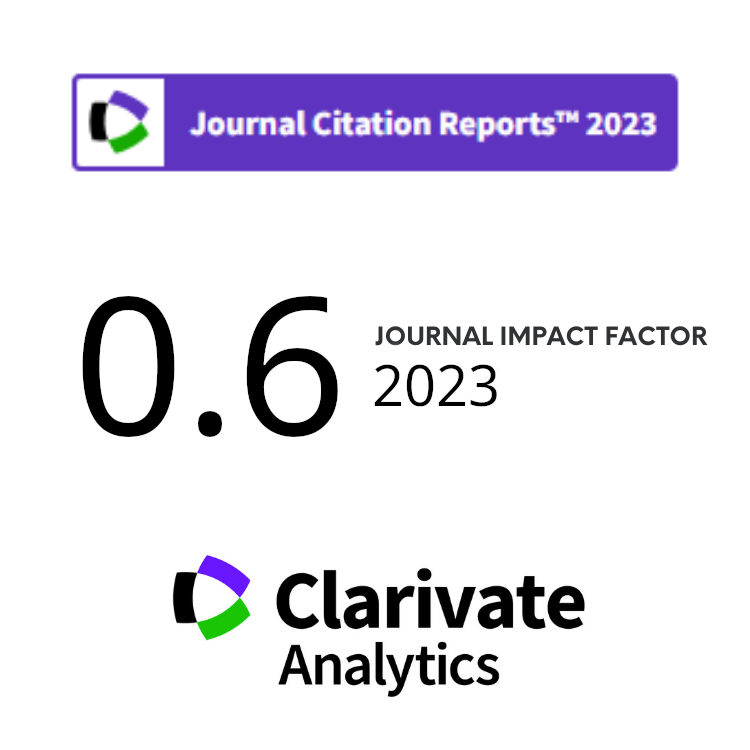Carbone or Oxygen Therapy: A Comparative Dosimetric Study Using PHITS Code
Abstract
Keywords
Full Text:
PDFReferences
H. Bethe, Ann. Phys. 397 (1930) 325.
V. Raj, A. Rai, S. Sharma et al., J. Anal. Pharm. Res. 7 (2018) 175.
J. E. Scaife, G. C. Barnett, D. J. Noble et al., Br. J. Radiol. 88 (2015) 20150172.
A. Bardane, J. Tajmouaati and A. Maghnouj, Moscow University Physics Bulletin75 (2020) 58.
A. Boukhellout, N. Ounoughi and F. Kharfi, Radiat. Prot. Dosimetry 198 (2022) 31.
A. Khorshidi, A. Rajaee, M. Ahmadinejad et al. Phys. Scr. 89 (2014) 095001.
P. Azimi and A. Movafeghi, International Clinical Neuroscience Journal 3 (2016) 59.
J. S. Nabipour and A. Khorshidi, J. Med. Imaging Radiat. Sci. 49 (2018) 194.
U. Amaldi and G. Kraft, Reports on Progress in Physics 68 (2005) 1861.
I. Kantemiris, E. P. Pappas, G. Lymperopoulou et al., J. Pers. Med. 13 (2022) 1.
C. Kurz, A. Mairani and K. Parodi, Phys. Med. Biol. 57 (2012) 5017.
T. Sato, Y. Iwamoto, S. Hashimoto et al., J. Nucl. Sci. Technol. 55 (2018) 684.
K. Iida, A. Kohama and K. Oyamatsu, J. Phys. Soc. Jpn. 76 (2007) 44201.
T. Ogawa, T. Sato, S. Hashimoto et al., Phys. Rev. C 92 (2015) 24614.
S. Furihata, The GEM Code - the Generalized Evaporation Model and the Fission Model, in: Advanced Monte Carlo for Radiation Physics, (2001) 1045.
H. Hirayama, Y. Namito, A. F. Bielajew et al., The EGS5 Code System, 1-1 Oho, Tsukuba-shi Ibaraki-ken, Japan (2005).
N. Ounoughi, Y. Dribi, A. Boukhellout et al., Pol. J. Med. Phys. Eng. 28 (2022) 160.
H. Weick, H. Geissel N. Iwasa et al., GSI Scientific Report (2017) 2011.
D. Satoh and T. Sato, J. Nucl. Sci. Technol. 59 (2022) 1047.
S. Agostinelli, J. Allison, K.Amako et al., Nucl. Instrum. Methods Phys. Res. A 506 (2003) 250.
A. Ferrari P. R. Sala and A. Fasso et al., CERN-2005-010, INFN-TC-2005-11, SLAC-R-773, CERN-2005-10 (2005).
G. Battistoni, F. Cerutti, A. Fasso et al., The FLUKA Code: Description and Benchmarking, AIP Conf. Proc. 896 (2007) 31.
L. S. Waters, G. W. McKinney, J. W. Durkee et al., AIP Conf. Proc. 896 (2007) 81.
A. V Dementyev, N. M. Sobolevsky, Radiat. Meas. 30 (1999) 553.
T. D. Malouff, A. Mahajan, S. Krishnan et al., Front. Oncol. 10 (2020) 82.
Anonymous, NASA Space Radiation Laboratory. https://www.bnl.gov/nsrl/userguide/bragg-curves- and-peaks.php. Retrieved in March (2023).
H. F. Ou, B. Zhang and S. J. Zhao, Nucl. Instrum. Methods Phys. Res. B 396 (2017) 1825.
M. Toppi, A. Sarti, A. Alexandrov et al., Front. Phys. 10 (2022) 1.
C. K. Ying, D. Bolst, A. Rosenfeld et al., J. Med. Phys. 44 (2019) 263.
L. Rezaee, Razi J. Med. Sci. 25 (2019) 85
V. Vernanda, A. Azzi, S. A. Pawiro, Atom Indones. 49 (2023) 7.
DOI: https://doi.org/10.55981/aij.2024.1352
Copyright (c) 2024 Atom Indonesia

This work is licensed under a Creative Commons Attribution-NonCommercial-ShareAlike 4.0 International License.












